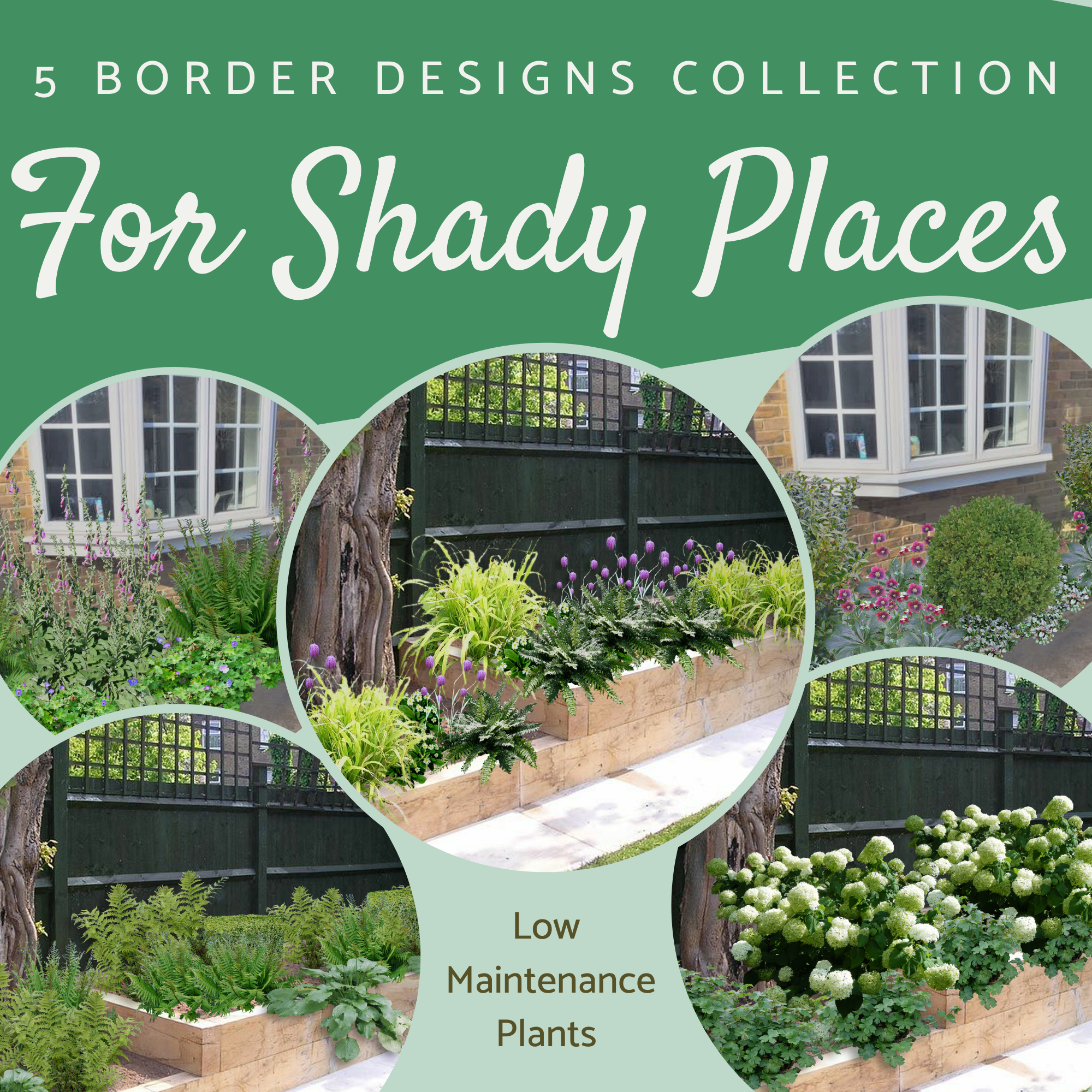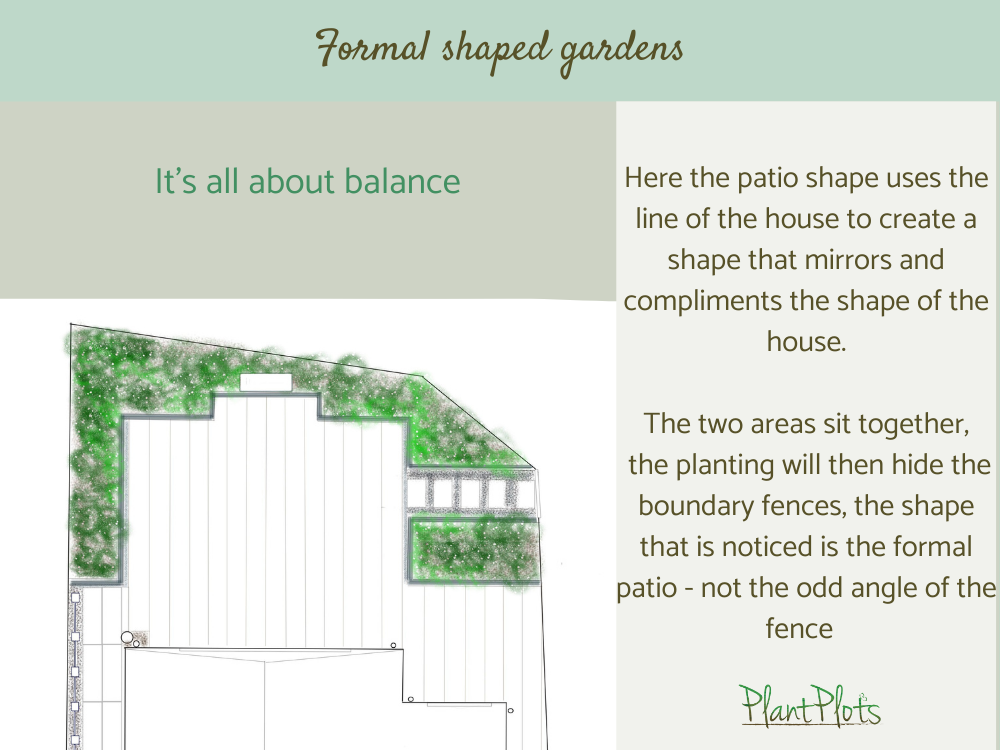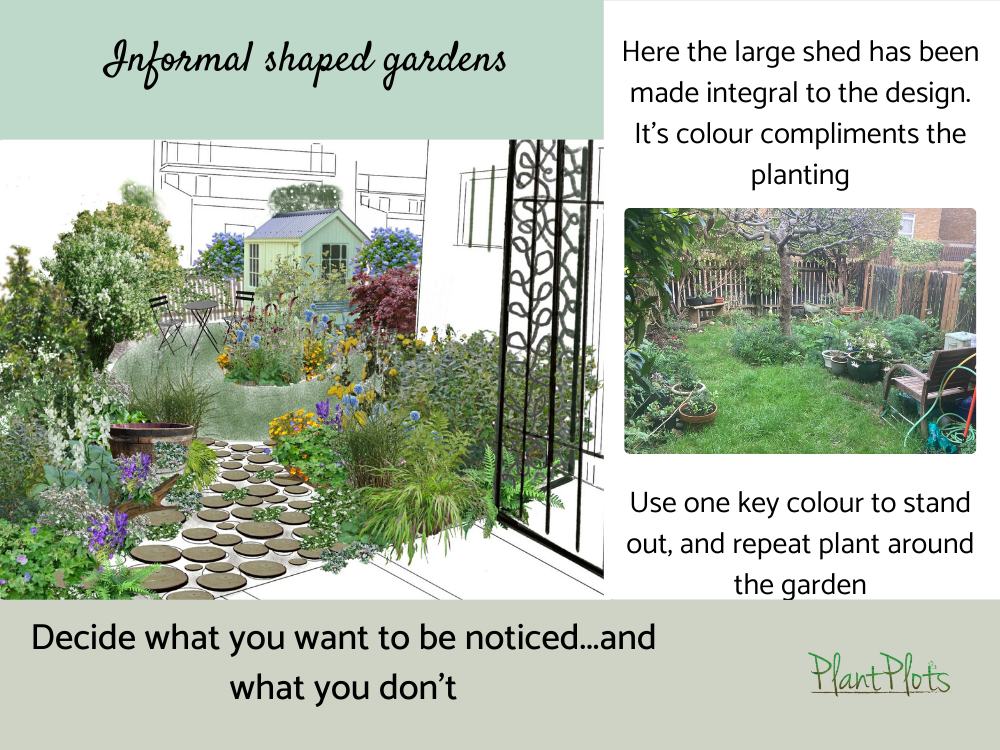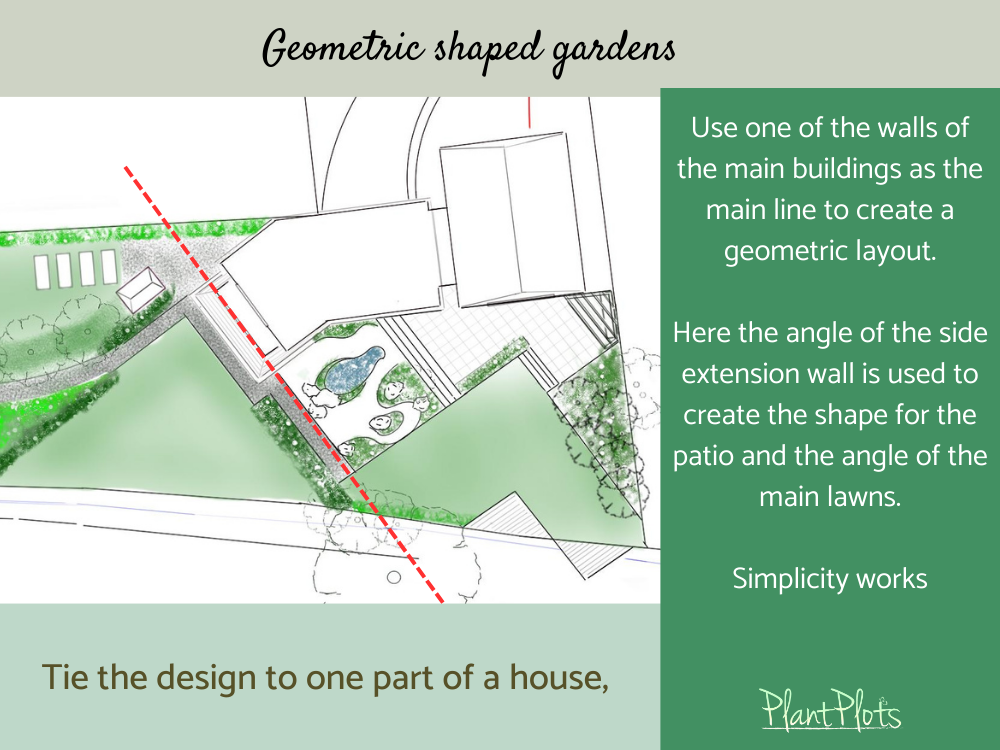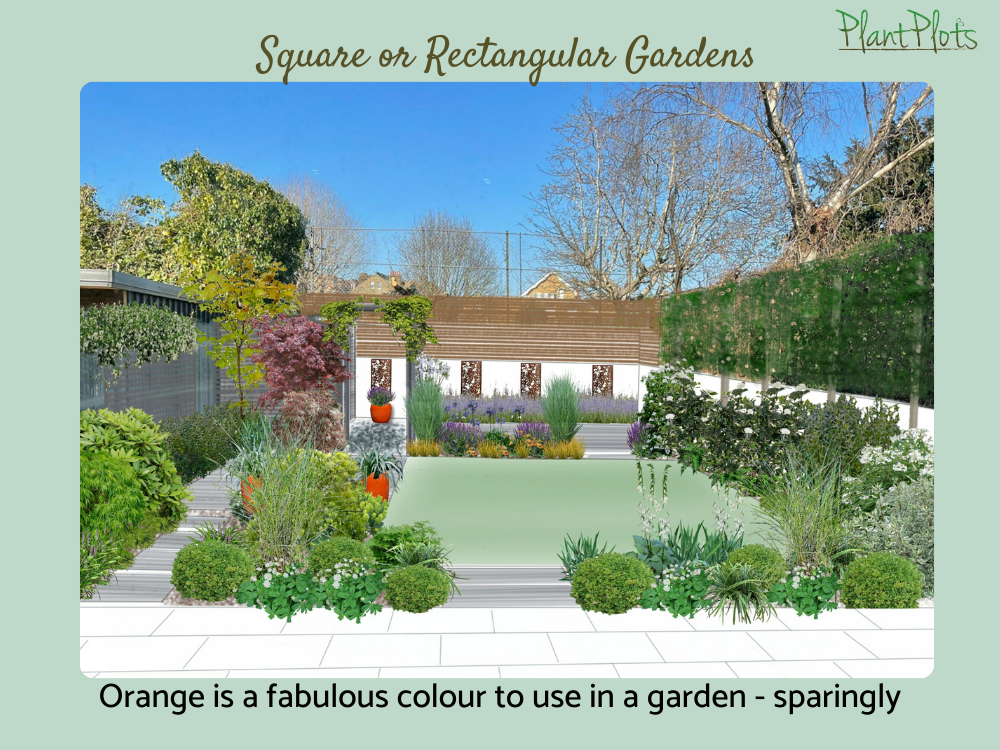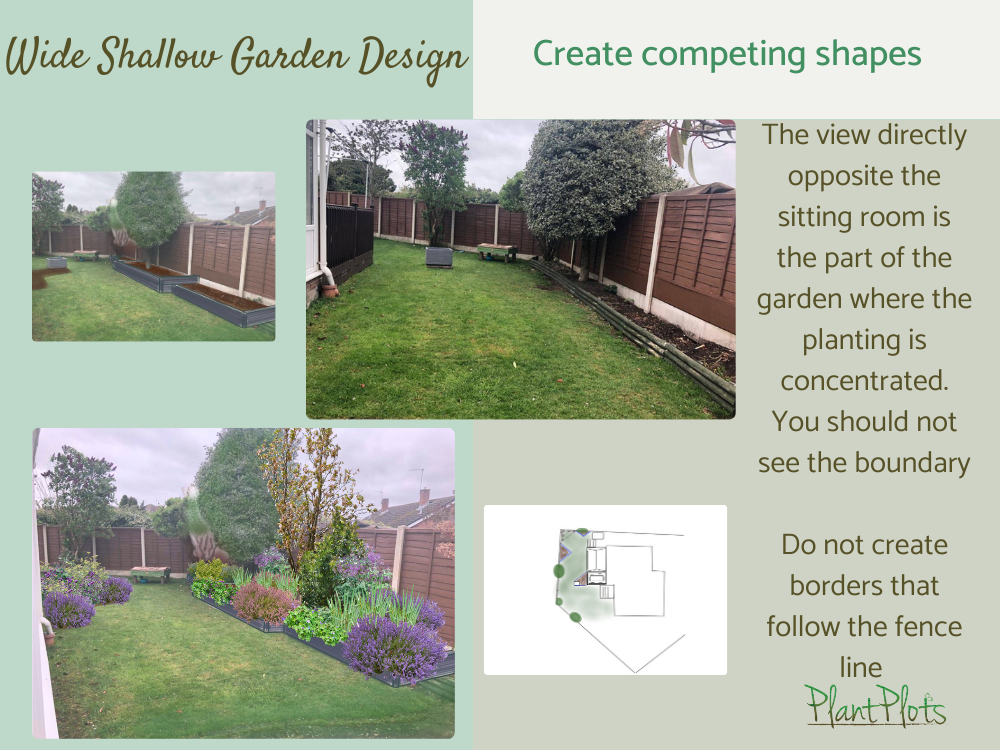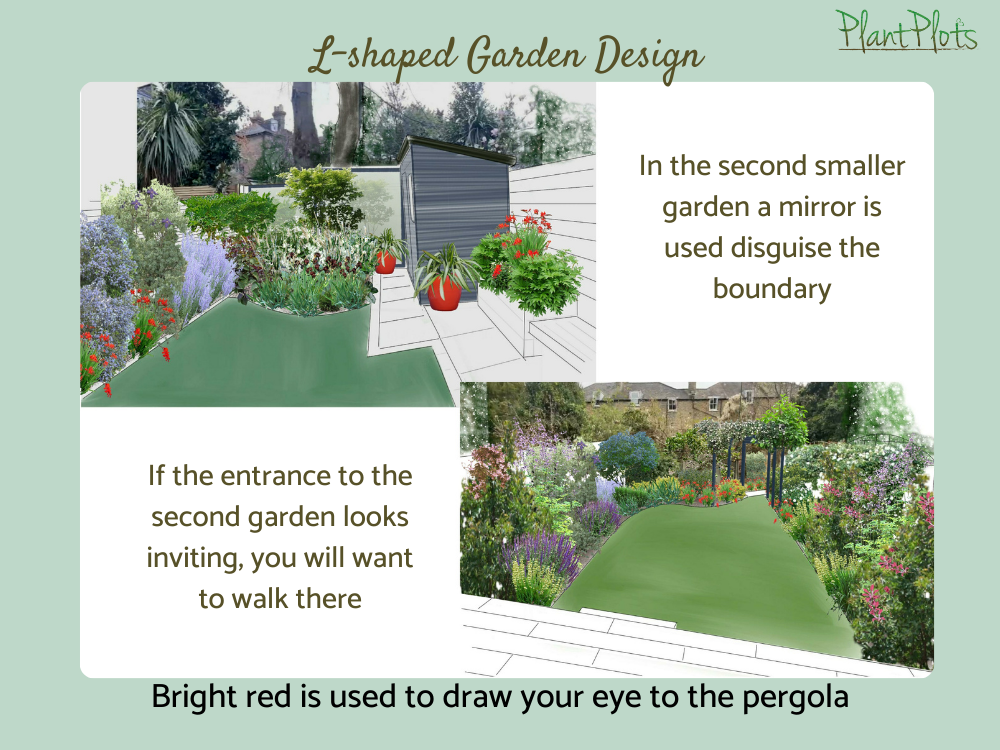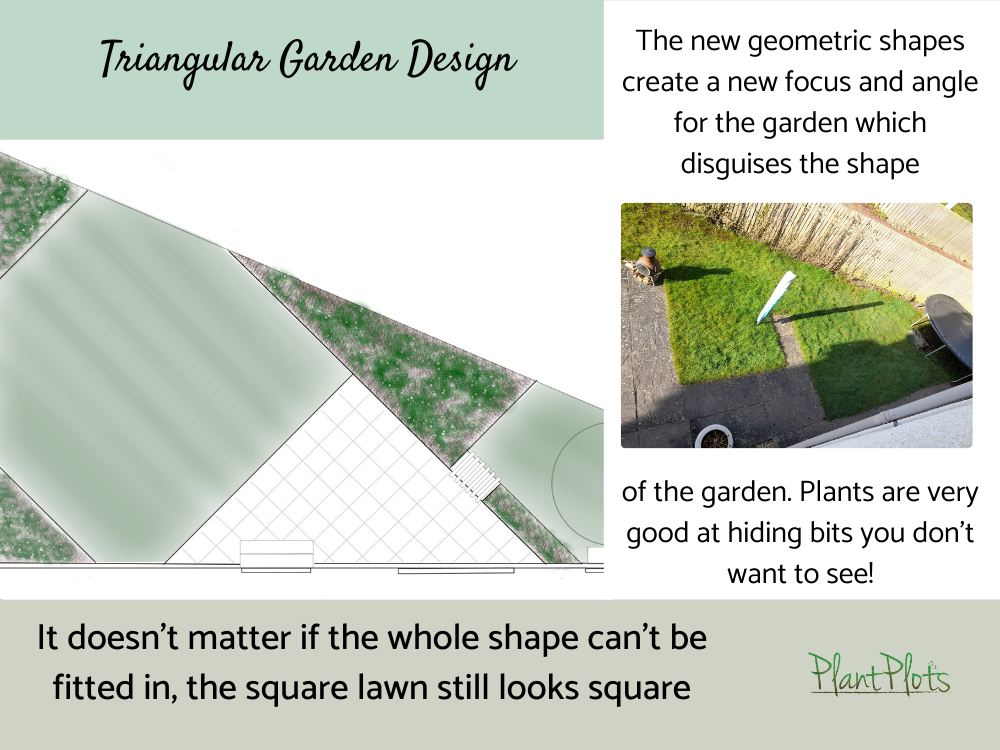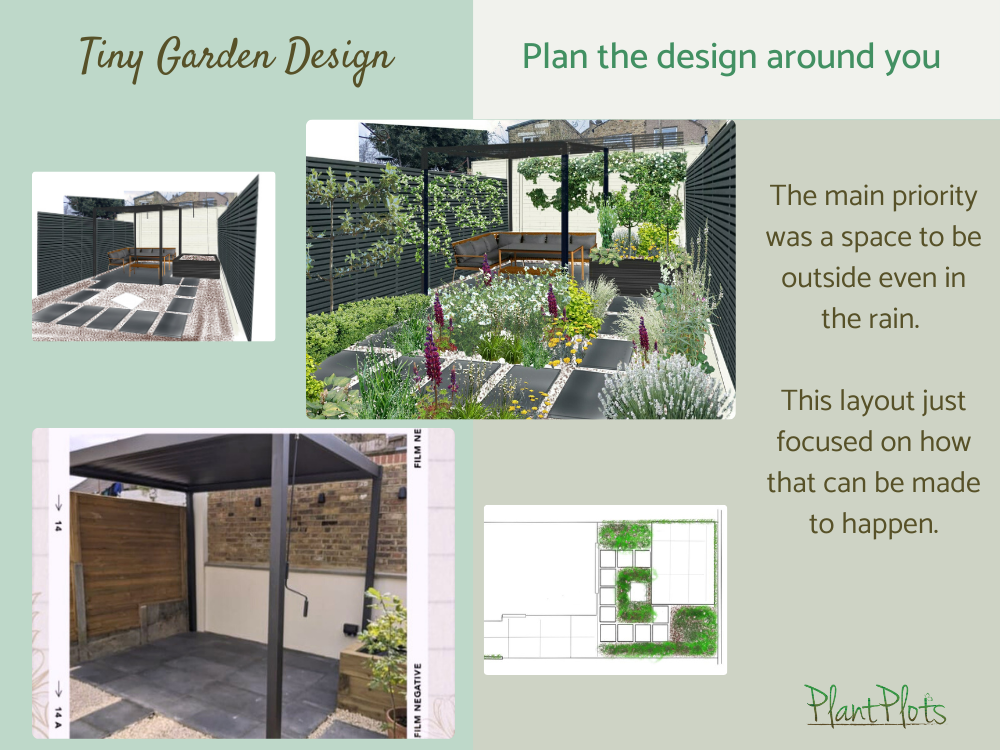
Which Garden Design Layout Suits Different Garden Shapes?
Over the years I have created hundreds of garden designs but there are only so many different shapes a garden can be. So what type of garden design layout suits a particular garden shape. How can you decide which layout will work best in your garden?
This post looks to simplify the process of designing any garden, by dealing with the issues most gardeners face.
- Learn the three main design styles, what these are designed to create and how these work with different shapes of gardens.
- How you go about solving common design issues most garden owners face.
- How you start, what to think about and how to begin to plan the new design layout.
Most of the images used are from our customer’s gardens, which have been transformed using these simple principles.
I hope you find this article useful, but if you still need a little help, please get in touch. You can also book a design consultation to chat about your garden design issues.
Use the online service to design your garden or just grab a coffee and watch some design videos
Try our online garden design service
Gardens come in all shapes and sizes, but the design principles are the same. Use the buttons below to find out the best design layout for your garden shape.
The 3 main Design layouts
If I asked you to name some different garden design types, you would probably think of cottage, modern, contemporary, or natural to describe the design, but these are not the design layouts, these are the emotional styles the garden creates. There are actually only 3 main types of design layout – formal, informal and geometric.
So what are these design layouts and their main identifying characteristics but most importantly, which garden design layout works best in your garden?
Formal Gardens
It’s about synergy and balance
Formal gardens use regular shapes set out in an orderly way showing you exactly how to use the garden. These shapes fit together to create different areas, but in a way that feels familiar. The design orient itself with the shape of either the house and or the garden. It seems as though everything is joined together in a simple uncluttered way.
Layout
Formal gardens don’t only use straight lines, circular shapes can also create a sense of formality. The key element is these shapes are easily recognisable and repeat in different sizes around the garden. Paths can link these spaces or skirt around them. It feels orderly and balanced.
Pro’s
Simple shapes are easy to create and layout in a garden. Formal designs then can be easier to create. Patio sizes for example can be created in whole paver widths, making build costs a little cheaper (less cutting).
Best for
Formal shapes are good for beginner gardeners. They are easier to create and suit most small square or rectangular gardens. If the garden is an unusual shape, formal gardens can use the familiarity of the regular shapes to hide the odd-shaped areas.
Informal Gardens
Informal Gardens are all about Escapism
Most of us live in urban areas; we are surrounded by solid hard objects; such as buildings and roads. There are signs telling us where to go and what to do. The role of the informal gardens is to provide you with a space to disappear into and escape from the world outside. They deliver a strong emotional connection with nature and provide a buffer to the environment beyond the fence
Layout
Informal gardens are not created by introducing wobbling-shaped borders or lawn shapes. They are created by providing by offering different routes to explore a space, they may have places to stop and sit. There will be areas you can’t see or be seen from. The spaces feel less structured; less is more.
Pro’s
These types of gardens allow us to feel more in tune with nature, by definition they should be relaxing spaces. Plants grow into their natural shapes, and nature is welcomed in. All of which means that often informal gardens can be easier to look after than formal gardens.
Best for
Informal gardens are well suited with awkward garden shapes and or when the topography is tricky. If the ground is sloping for example, create the borders with the natural shape of the land. Informal gardens can also be cheaper to build and plant, as usually less hard landscaping is used, it is easier to alter and adapt the garden in the future.
Geometric Gardens
These gardens use their shape to distract you
Whenever there is a design challenge in a garden, there are generally 3 possible solutions routes; disguise, enhance or distract. Geometric gardens use the shapes they create to make you notice them, creating focal points where you want to look. This distracts your attention from the area or issue in the garden you don’t want to notice.
Layout
Geometric garden shapes twist the orientation of a garden. Bold shapes cut across either the orientation of the house or the fences. These don’t have to be a whole, partial shapes can be used to create interesting areas and spaces for planting. Tall plants hide the boundaries making the geometric shapes created the focal points.
Pro’s
By thinking a little outside the box, geometric gardens can be spectacular, and interesting places. Often more usable space is created especially in small awkward spaces, with plants being used to fill in gaps. These gardens can be a very efficient use of space.
Best for
Odd, weird and triangular shaped gardens. Use in very small gardens or courtyard spaces to maximise usable space and minimise dead space. Geometric gardens are really adaptable, they can be planted with chic monochromatic plants or filled with an effusion of flowers.
Starting to Plan the Design
It’s all about you understanding your needs
You may think that planning the layout of the garden first starts with spending hours on Pinterest or Google searching for images of gardens you like. The trouble with this, is that you end up fitting the design layout of your garden to the image and not to you!
What I mean is that you have to consider how the garden needs to function, to make you happy BUT having also considered how Mother Nature will aim to spoil things!
So the start of any design process is actually to ask yourself lots of questions like:
- Why do I sit in the garden?
- What annoys me about gardening?
- When are my favourite times of the day to use the garden, and where are my favourite places?
- How do I want to feel?
- What do I like doing in the garden?
- What spoils my garden?
You will start to understand the role your garden needs to play in making your life better. This is all gardens really do, they simply improve the quality of our lives, by delivering us an emotional experience that makes us feel good.
Consequently, copying a layout you see in a book or downloaded from the internet will not make the garden fit you – instead you are forced to fit the design.
Garden design is about meeting your needs not adding features
Having made a list of likes and dislikes, desires and potential problems, what do you do next. This is the most important part!
Start by eliminating the negatives
Ask how those things you would like to have in the garden will be affected by your environment and Mother Nature AND how annoyed it will make you feel. This is how gardens easily become unwanted chore-ridden spaces. You end up slaving away to keeping the effects of Nature out of your garden. By this I mean, dirt, debris, leaf fall, detritus, muddy grassy areas, slippery paths, green algae, dead and dying leaves, mess, water, puddles …. etc. This becomes or can become unnecessary work simply as you had not considered the negatives.
Eliminating the negative effects or at least ensuring these are easy to deal with reduces the maintenance time in a garden – meaning you can spend more time enjoying being in it! Take these images below, consider how would nature change alter or generally mess up the layout.
Ask whether the material or hard landscaping you are using will function well given these effects. If you are happy they will, then great, you are planning a design around how much time you have to look after the garden as well as formulating a layout that works for you and your family.
Lastly, with all design remember the garden is a 3-dimensional box, this whole area needs filling. When you begin to plant start with eye-level plants first, then add height in strategic places to create privacy and then use lower growing plants to fill in gaps.
Sometimes you don’t need a design, you just need a little professional advice to sort out part of the garden.
Book your design consultation.
Helping you make your garden better
Square & Rectangular Gardens
Square & Rectangular Gardens
Most gardens are generally regular shapes, some square and some rectangular. This means you generally have three long lines of boundaries to contend with. How you create a design then depends on the priorities you have set for yourself. However, for the design to not simply fit inside the space, you need to hide some of the boundaries. This means you don’t see where your garden ends at the top and the bottom of the fence.
You cannot hide all of the boundary, this replaces the vision of the fence with a clipped green wall of hedging – you have gained nothing in terms of a visual distraction. Consider which part of the boundary is the most important to ‘hide’, it may be the fence nearest the seating areas, or maybe its the fence at the end that marks the end of your space.
Large central lawns do not make a garden feel bigger or make them more usable
Formal Gardens: Look to create a flower border closest to where you will sit the most. Use one shape in different sizes to create different areas. Do not create borders around all the edges by the fences. This just highlights the fences or boundaries
Informal Gardens: Think about the flow, when creating a border, does the sweep of the border feel like it could have been created naturally? Focus on creating a contrast of movement of the plants against the static hard landscaping. We are hard-wired to watch things that move.
Geometric Gardens: Use geometry to focus your attention on the shape of the design because you don’t want to notice something else. Make sure you orient how you would sit out, so your field of view is filled with the things you want to see.
Long Narrow Gardens
Long Narrow Gardens
The first decision that needs to be made is whether you want to embrace the shape or whether you would like the garden to feel less thin and find ways to give the impression of more space or width.
If you choose to focus on the length as part of the design, then there has to be a reason for you to walk the full length of the garden, so there has to be something to look at when you get there. If the end of the garden where you will spend your time, then much needed storage space, for example, can be walked past as you walk to the far end.
If the focus is on creating the feeling of more width and space, then the walk down the garden has to use three design tricks.
- You can’t see right to the end of the garden
- The garden has punctuation places, areas where you stop and look at things
- The route along the garden is not a straight line,
Understand how you see things:
We are hard-wired to notice anything that moves, ( it helped us run away from predators in pre-history) contrasts (light over shade) and also straight lines. Our eyes follow the line to the end.
These can be use to your advantage to create the distractions from the narrowness of the garden.
Formal Gardens: These can be created, but you need to partition the garden. Each section of garden has an entrance and exit, and possibly a different theme. Use tall screens to hide the view of one section from the other.
Informal Gardens: You can use the same principle as above, but the journey along the garden is more about ‘stop and look’ Here you would add sensory planting along the way. Plants you want to smell, touch or taste.
Geometric Gardens: Work really well in narrow spaces. Use the straight lines of the pathways at odd angles to create visual lines to follow. Again it is really important to use height to blur the top of the fence lines. This prevents the fence line from competing for attention with your new odd angles.
If you are a bit stuck on where or how to begin, book a chat with Rachel
Book a 1 hour or 30 min call – visit the shop to book
Learn more about our service.
Wide Shallow Gardens
Wide Shallow Gardens
You may think that a wide shallow garden shape presents the same design issues as a long narrow one; it is after all just rotated 90 degrees, but it doesn’t. Once again it is all about how you perceive things and how you see.
The longest fence usually runs parallel to the rear of the house. The issue is the width of the fence extends beyond your peripheral vision, and because our eyes follow straight lines, we then look from side to side to see the garden.
This makes that end fence appear closer and it certainly appears the most dominant feature in the garden. So what to do?
The simplest approach is, if possible, to reposition your main seating area so that it looks down the length of the garden. Which is fine for when you are outside, but not so useful when it comes to the view from inside the house.
In this case you need to create pockets of interest on the fence. The boundary is simply too big to hide, so your options are to distract or decorate. Part of the top of the fence needs to be hidden, this will help break up the lines. Then add some ‘lookie here’ features; this can be a mirror-backed trellis for example or a piece of fence art. All you are trying to do is reeus attention onto something more attractive.
Change the views by moving the seating area and using the fence as a place to showcase interesting things
Formal Gardens: Using vertical height is the key to creating a more structured formal layout. Tall posts, Obelisks, Pergolas or small trees will demand your visual attention more than the shallowness of the garden.
Informal Gardens: These gardens work best if boundaries are blurred, which is more tricky if the fences are close to the house. If the main seating area is set to one end of the garden, you can create that sense of planting depth more easily. Alternatively, bring the planted border close to the house so you can look through it from the house.
Geometric Gardens: Work well in this shape of garden, you can play with the angles creating lines and focussing views along the length of the garden
L-Shaped and Corner Gardens
L-Shaped & Corner Gardens
Gardens are created in all manner of shapes and sizes these days, but L-shaped and corner gardens are some of the hardest to design. In essence, there are two gardens, one wide and shallow and the other small and narrow, which makes designing them a challenge.
The key point is to think of them as two separate gardens but link these using repeated colours, objects, scents and plants. The starting point as always, is to plan around you first. There is likely to only be one possible place you can use to sit outside, so the design starts from this point and how you get there.
Concentrate on the view from the seating area, it may be that there is only enough space for one border, so make this as large and deep as possible. You need something to look at! Then link the two gardens with an entrance of some sort. There has to be a reason to go into the other garden, so make sure it is worth your while. It could be you have created a tiny area for a sneaky sunbathe, or this small space is filled with only scented plants for example.
Make an entrance; it makes us want to see whats on the other side
Formal Gardens: This type of design suits this type of layout. Keep to one simple shape that is repeated in different sizes. It doesn’t matter if one of the shapes overlaps another shape, it will make the garden more interesting. Then if the view is to the corner with the entrance, make this a real feature.
Informal Gardens: If space is limited or the width of a garden area is particularly narrow, lose the distinction between the walkways and borders. Use a medium you can walk over and also plant into. You will then walk in with and amongst the planting to get around the garden. The junction between the two gardens still needs to be a feature that invites you to walk through it, but it feels like the garden is wrapped around you.
Geometric Gardens: Given the dual challenges presented by these type of gardens, I would not try fit an asymmetrical design in here Informal is easier!
Fortunately, L- shaped gardens are not very common still… but if you are really struggling, book a design consultation and I can help you.
Front Gardens
Front Garden Design
The most important point to remember is that a front garden is NOT just a smaller version of a back garden. It is both an entirely functional space as well as a place of transition. It also tells the world something about the person who lives inside.
Front garden design is all about practicality, ensuring you can exit your car and get to the front door easily. Your visitors navigate through the garden to your door, this has to be easy and the most obvious route, without obstacles.
The front garden also acts as a buffer for you, when you leave your home, you exit via the front garden, your garden is also the first part of the home you enter, so it should also feel welcoming.
The basic principle behind any design is that it does the job. Give yourself enough space to move around without having to step off paths or driveways to get where you want to go. Once that is sorted, you can add spaces for plants.
The next issue is a lawn. If the area available is shaded, surrounded by hedges or is small, it is probably better to avoid using grass altogether. Avoid the border around the edge lawn in the middle design format… those are better in back gardens.
Decide what you want the front garden to say about you – and say it!
Most front gardens will have 2 main areas for plants to go, one is along the border fence or along the edge of the drive. The second is the space left when the drive and path to the front door have been built.
So the layout is really about the planting design rather than the layout design. This is where your personality will shine through. I have given you some ideas for different layouts and ideas in the designs I have created for customers. Enjoy experimenting!
If you are a bit stuck on where or how to begin, book a chat with Rachel
Book a 1 hour or 30 min call – visit the shop to book
Learn more about our service.
Triangular Gardens
Triangular Shaped Gardens
Back in the good old days, houses were built in straight lines with front and back gardens that were even in shape, now anything goes. Triangular gardens are becoming more common, so how do you design a garden in a triangle?
The shape is restrictive, but you have two main options. To tuck the seating area in the pointed end of the garden, utilise the widest part of the garden for your ‘view’ and play space. Or you reverse the format, give yourself as much room as possible, and hide the pointed end with planting. The determinent for the decision is the amount of space you need to have for seating. Does the space have to fit 2,3, or more people. If you are to enjoy the garden properly, do not compromise your comfort by squeezing this area down so it fits into a corner.
The design must fit around the space you need first.
The space fits around you
Formal Gardens: Due to its shape, it is difficult to create a sense of balance in a garden like this
Informal Gardens: Don’t try to hide all the boundaries with planting, instead creat one large deep area of planting. You can place a mirror ar the back of the border to give the impression of more space. Then focus on making the boundaries more interesting – search for fence art ideas.
Geometric Gardens: If the garden is big enough, then altering the focal points and using hard landscaping can create a really interesting space. Remember to think in 3 dimensions though, you need height to make the design more effective.
Weird & Odd Shaped Gardens
Weird and Odd-Shaped Gardens
I have created designs in some odd-shaped places or where there doesn’t appear to be space for a garden. To create a garden in an odd space, the key is understanding two things, what you are trying to create; for you and how the space will prevent you from achieving that.
It may be that you have a small area you’d love to sit out in, but that it has no privacy, or the area you have available is shaded and dark or surrounded by high walls. The design or layout created then is all about eliminating the negatives. In the above example, this involves finding a way to get a sense of privacy without boxing you into a space, or considering how those shaded walls can be made more appealing or attractive.
Once you find solutions to these issues, you can then focus on the emotional aspects. You want to feel warm and cosy or you’d love to look at pretty fairy lights and breathe in the scents in the air for example, this will then help determining the planting scheme that best delivers that for you.
Rather than think you need a ‘design’, focus instead on how the layout will maximise the benefits and reduce the negative aspects.
What must the garden deliver?
As with triangular-shaped gardens, no specific design style would best suit an awkward garden shape or layout, as your aim is to create the garden around your needs. However, the main design principles remain.
- Decide where you are going to sit out and design the space around here
- If there are parts of the garden you don’t want to see, think about how best to lessen their impact on your view
- That could be using distraction, hiding it or making that element more attractive.
- Ensure you cannot see all of the boundaries
- Consider the micro-views; what do you see looking out through a window for example.
- Make sure the garden appeals to all five senses, think sight, sound, touch taste and most importantly smell.
See also small garden design
Tiny Garden Spaces
Designing Tiny Garden Spaces
Every space deseves the opportunity to become a garden, but when space is limited, it is hard to create the feeling of being in a garden, when you simply don’t have enough space for anything.
The primary consideration is you and the space you will use and need. Do the maths, you need to see how much area you will use, compared to the area you have available to use. Place a table and chairs in the space, walk around it, see how much space you as a person use. The garden is then created around the space left.
Small gardens are primarily sitting spaces, so using raised borders to lift the plants above ground level brings the planting to your level when you use the space. There is not much space for planting, so you need to consider the job function for every plant you will add into the space, these plants have to deliver of several level; they can’t just be a pretty flower for 3 weeks and a boring green plant for the other 49. Think about what the plant has to do, is it that it attracts insects or has scented leaves? Does the plant create attractive shadows on the wall or can it be used to grow another smaller plant through it.
see also courtyard gardens
Focus more on practicality
Formal Garden: Tiny spaces benefit from a simple structure. This is all about minimum not maximum, one large planter is better than 3-4 smaller ones. It is easy to add clutter to the space, your movement in this small space must easy. Use raised planters that double up as ‘bum rests’ if you need some informal seating.
Informal Gardens: the informality is not created in the traditional sense, you cannot wander around this space, it is too small for that. Instead think about flexibility and change. Can the layout be altered by using planters on wheels. Use lots of seasonal bulbs, this will change the look of the garden throughout the year. You can layer lots of bulbs in tall large planters, increasing the diversity of display.
Geometric Gardens: The space is too small to start playing around with perspectives, so these are not the best choice.
If you are a bit stuck on where or how to begin, book a chat with Rachel
Book a 1 hour or 30 min call – visit the shop to book
Learn more about our service.
Planting ideas
Border Plans and Garden Advice
Unsure what plants to use? No problem, just use one of the border designs we have created. You’ll know what to plant, how many to use and how to look after them.



